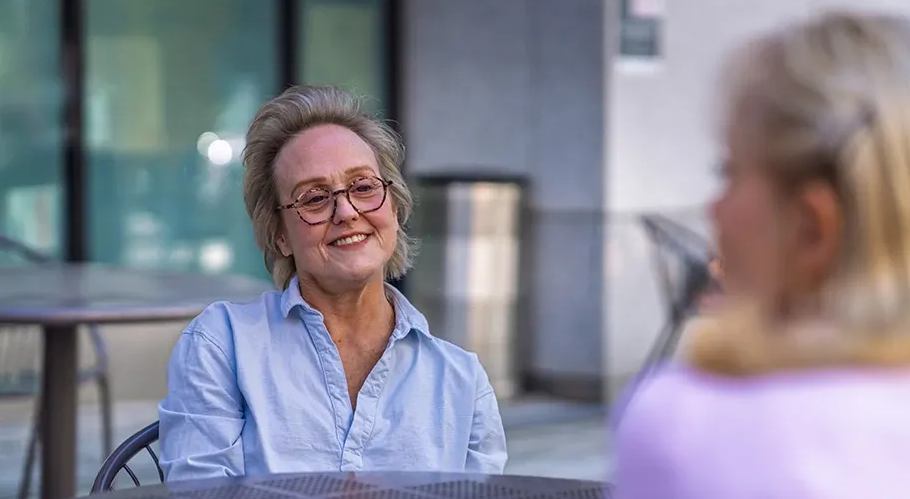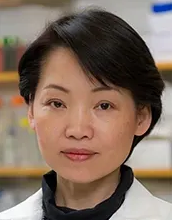
How Dana-Farber Research Delivered New Medicines and Long-Range Hope for a Patient With Metastatic Breast Cancer

Nancy Lin, MD
In 2018, Kathleen McEvoy-Schufreider, a 60-year-old communications executive living in Haverhill, MA, was finishing chemotherapy treatment for a recurrence of breast cancer. It was her second bout with chemotherapy since her initial diagnosis in 2011 and her doctor, breast oncologist Nancy Lin, MD, wanted to find a post-treatment option that would delay any need for more chemotherapy.
Lin suggested a phase 3 clinical trial called PATINA. The trial was exploring a new combination therapy for use after treatment of advanced HER2-positive, HR-positive breast cancer to keep the disease from worsening. (HER2 stands for human epidermal growth factor receptor 2; HR stands for hormone receptor.) McEvoy-Schufreider, who had already participated in one clinical trial at Dana-Farber, signed on.
The trial, led by Dana-Farber oncologist Otto Metzger, MD, was rooted in decades of research at the Institute. For more than 30 years, oncologists have been infusing basic science labs with questions inspired by observations in the clinic. This has led Dana-Farber scientists to make discoveries that changed the way patients are treated.
Three separate research labs contributed substantially to the knowledge and evidence that built the foundations for the PATINA trial, which has dramatically improved outcomes for patients — including McEvoy-Schufreider.
"I saw the pace of progress firsthand," says McEvoy-Schufreider. "When you have an ecosystem that is really dedicated to this kind of science, you can move mountains."
The Early Science
In the 1990s, cell biologists were still learning the ins and outs of cell division. It takes about a day for a cell to divide. During that time, the cell goes through a tightly controlled cell cycle process. There are deliberate pauses between each step in the cycle to ensure the cell doesn't proceed until it is ready.
The late David Livingston, MD, a renowned Dana-Farber investigator, focused his attention on the mechanisms governing the first of these pauses. By the mid-2000s, his work and the work of Geoffrey Shapiro, MD, PhD, senior vice president of Developmental Therapeutics at the Institute, had helped identify the key enzymes that regulate this pause: cyclin dependent kinases 4 and 6, or CDK4/6, and their activators, D-cyclins. They also found that these proteins tend to show up in abundance in several cancers, particularly in some forms of breast cancer.
These discoveries put CDK4/6 proteins in the crosshairs as targets for drug development because they are needed for cancer cells to divide and grow. The challenge, however, is that every multiplying cell in the body goes through the cell cycle. Blocking a regulator of the cell cycle could be toxic to all multiplying cells, not just cancer cells.

Peter Sicinski, MD, PhD
"The dogma in the field was that those proteins were off limits because cell division is such a fundamental process," says Dana-Farber researcher Peter Sicinski, MD, PhD.
Sicinski, however, challenged that dogma. His laboratory created an experimental model enabling his team to determine if the CDK4/6 proteins were required for an animal model to develop and survive. They found not only that the animals survived without CDK4/6, but also that the animals were resistant to breast cancer. In addition, when they blocked CDK4/6 in animals with breast cancer, the breast cancer stopped growing without harming the animals.
"These studies opened the door to targeting the CDK4/6 kinases for breast cancer treatment," says Sicinski.
Dana-Farber patients were among the first in the world to receive these drugs as part of phase 1 clinical trials. The first clinical trials of CDK4/6 inhibitors focused on HR-positive/HER2-negative breast cancer, as studies had shown that this form of the disease was most sensitive to the treatment. Those trials led to U.S. Food and Drug Administration (FDA) approval of the first CDK4/6 inhibitor, palbociclib, in 2015. Approvals of two others, ribociclib and abemaciclib, followed.
One Diagnosis After Another
McEvoy-Schufreider, however, was diagnosed with HER2-positive breast cancer, so she wasn't eligible for trials focused on HER2-negative disease. She was, however, able to benefit from the advent of HER2-targeted therapies, such as trastuzumab, which had revolutionized treatment of this form of breast cancer.
For her initial treatment in 2011, Lin recommended a trial that aimed to learn whether a new regimen with trastuzumab could enable some patients to safely skip a difficult form of chemotherapy called the AC regimen (Adriamycin and cyclophosphamide). After 16 weeks of paclitaxel chemotherapy plus trastuzumab, McEvoy-Schufreider's tumor had not vanished. She went on to receive four doses of treatment with AC after surgery, plus radiation, and then tamoxifen for five years to reduce the risk of recurrence.
McEvoy-Schufreider completed her five years of tamoxifen, but soon after she started feeling pain in her ribs. By early 2018, she learned her cancer was back, and it had invaded her liver, bones, and brain. The treatment this time was longer, 26 weeks of paclitaxel and trastuzumab, plus a new drug, pertuzumab, that also targets HER2.
"A lot has changed since 2011," says Lin. "Nowadays, many new and highly effective therapies are available."
McEvoy-Schufreider has experienced that first-hand.
"One of the most fascinating things to me was the pace of research," says McEvoy-Schufreider. "In those years since my first diagnosis, there was already a new drug available."

Kathleen McEvoy-Schufreider (left) talks with Jennifer Lowell, RN, BSN, who was McEvoy-Schufreider's oncology nurse from 2011 until her retirement in 2025
Meeting a Clinical Need
In the time between McEvoy-Schufreider's two treatments, science was advancing medicine in ways that she didn't yet realize would directly affect her.
Specifically, breast oncologists at Dana-Farber noticed that some HER2-positive cancers were becoming resistant to anti-HER2 medicines like trastuzumab and pertuzumab. These drugs had dramatically improved outcomes for patients with HER2-positive breast cancer, but not everyone was seeing the same profound and durable results.
A Dana-Farber clinical fellow named Shom Goel, MBBS, PhD, who is now a physician-scientist in Australia, observed that CDK4/6 proteins were overly abundant in tumors that develop resistance to anti-HER2 medicines. Goel wondered if a combination of HER2-targeted therapy and CDK4/6 inhibitors would help overcome that resistance.

Jean Zhao, PhD
He brought the question to the Dana-Farber Cancer Biology lab of Jean Zhao, PhD.
"Medical doctors bring a lot of clinical questions to my lab, and we use models to address the questions," says Zhao. "They really want to know what is working, and if something isn't working, they want to know why."
In 2016, Zhao and Goel were able to confirm that CDK4/6 proteins were playing a role in resistance to anti-HER2 treatments and that combining HER2 targeted medicines with CDK4/6 inhibitors had promise. The results inspired clinical trials testing the combination in patients — including the PATINA trial.
"We found a mechanism and a therapeutic strategy, and we also showed that the strategy can work," says Zhao. "With that evidence, you can design clinical trials to test a new approach to treatment."
The PATINA trial was designed to look at a combination of the CDK4/6 inhibitor palbociclib, hormone therapy, and trastuzumab, and compare that with standard of care treatment: hormone therapy plus trastuzumab after treatment for metastatic breast cancer.
"We always talk about the importance of bedside-to-bench and bench-to-bedside research," says Lin. "We've seen the full circle of this process with CDK4/6 inhibitors and now we see this approach has directly benefitted patients like Kathleen."
Courage and Commitment
McEvoy-Schufreider joined the PATINA trial in 2018 after completing treatment for her cancer recurrence. In 2022, however, she had to stop participating because she discovered she had early-stage endometrial cancer. Under the care of gynecologic oncologist Joyce Liu, MD, MPH, she began chemotherapy, surgery, and a form of radiation therapy called brachytherapy.
"I never saw Kathleen lose hope," says Jennifer Lowell, RN, BSN, who was McEvoy-Schufreider's oncology nurse from 2011 until her retirement in 2025. "She and her family and friends love to laugh."
Through treatment after treatment, McEvoy-Schufreider counseled herself to have courage the same way she counseled her growing daughters as they faced important life decisions.
"What do I want to do? I want to survive this. What do I have to do? I need to commit myself to treatment," she says. "It's like getting on a train. If you just commit to getting on the train, and going through every stop, you will look back and be amazed at how far you've come."
After she completed treatment for endometrial cancer, McEvoy-Schufreider was not able to rejoin the PATINA trial. But a team of experts at Dana-Farber, including Lin, helped her get back on the trial drugs with insurance coverage.
She's been taking the combination ever since and enjoying all kinds of adventures, including fulfilling a long-time goal of paddleboarding. On a recent vacation, McEvoy-Schufreider and her youngest daughter spent four hours paddling, falling, resting, and enjoying a beautiful day on the water in Connecticut.
"I just kept paddling," McEvoy-Schufreider says. "Paddleboarding became a metaphor for learning to keep moving forward."
The first results of the PATINA trial, reported in 2024, revealed that patients combining HER2-targeted treatment, hormonal therapy, and a CDK4/6 inhibitor experienced significantly longer control of their cancer. On average, patients were able to delay their need for chemotherapy by nearly four years, with many still on the treatment beyond four years.
"The results of the study were very positive, showing a dramatic improvement with the addition of palbociclib," says Lin. "It's incredible to see all of this Dana-Farber science come together."
The Science Continues
The basic science has also continued. In 2017, Zhao's lab made an unexpected discovery showing that CDK4/6 inhibitors influence the immune system. They can amplify a cancer cell's production of alarm signals and can directly stimulate the activity of immune cells. This work contributed to the scientific underpinnings of the PACE trial testing the combination of palbociclib with immunotherapy in patients with HR+/HER2-negative breast cancer, led by breast oncologist Erica Mayer, MD, MPH.
With Lin's collaboration and tissue samples from breast cancer patients who volunteered to contribute a sample of brain tumor when they needed surgery, Zhao's laboratory has developed models to test new drug combinations for the treatment of brain metastases. Zhao has found that the combination of CDK4/6 inhibitors with anti-HER2 therapy effectively shrinks brain metastases in the lab.
Brain metastases affect up to half of patients with metastatic HER2-positive breast cancer. In 2018, McEvoy-Schufreider was found to have breast cancer in her brain, for which she received radiation treatment. As of 2025, her brain scans have shown no evidence of active cancer.
"The opportunity to do meaningful work is what motivates people in my lab," says Zhao. "We want to do the kind of science that will have an impact on patients."
Another pressing question is why patients with triple negative breast cancer don't respond to CDK4/6 inhibitors. Triple negative breast cancers are the most aggressive form of breast cancer and there is a dire need for new therapeutic approaches.
Sicinski says his lab has ideas for potential ways to make triple negative breast cancers more sensitive to CDK4/6 inhibitors, and that those ideas are testable in the laboratory.
"It is satisfying to see our work translated into clinical practice, but I don't like to sit around and be happy about past discoveries," Sicinski says. "We would like to make new discoveries. There are many, many unresolved issues in the clinic, and we as scientists want nothing more than to help resolve them."
By Beth Dougherty
